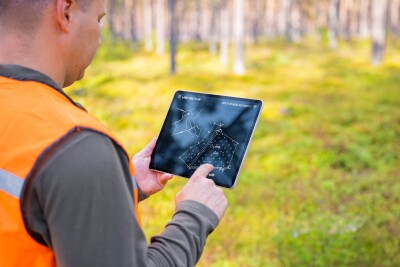While 3D printers have been getting much of the attention from start-ups using Kickstarter, don’t think the laser scanning community is sitting idly by. Two new desktop scanners hit the news last week, drawing attention right back to that data-capture starting point in the scan-to-print workflow that’s capturing the public’s imagination.
Of course, desktop and close-range scanners have been around for a good while now. Probably most well known is the NextEngine scanner, who tout themselves as the “#1 selling 3D scanner.” Starting at $3,000, it’s a relatively affordable way to get into 3D laser scanning of small objects like archaeological artifacts or machine parts you’d like to reverse engineer. Then there is the popular the David scanner, which you can buy as a “starter kit” for €450 or as a structured light scanner that comes in just under €2,000. David has done some great work in laser scanning, and inspired plenty of “makers” like this guy, but the “kit” nature of their solution has likely turned a few people off, even if the price is right.
Both of these are still considerably cheaper than the handheld scanners they most often would compete against: Even Artec, which pitches itself as a cheaper alternative to the Creaform solution, is at least $13,500 in the United States.
So, I’d say this Kickstarter project from CADScan is something of a game-changer: If you get it right now, you can get a professional, fully assembled desktop scanner for £649. The makers say they’ve designed it to be low-cost and “as simple to use as a photocopier,” with no post-processing and instant mesh. No point cloud to deal with if you rather not.
Here’s the full pitch (if you’re using Internet Explorer this probably won’t show up. Get a modern browser):
Now, it’s not the overnight success that the 3D printing pen (aka glorified glue gun) is, and is only about three quarters to the £80,000 goal, but there are 22 days to goal and I’m pretty sure they’ll be funded. The thing holding them back might be the sample data they supply.
Here, check out their scanned dragon (this time, IE will really let you down; you need a browser that supports HTML5, like, well, anything except IE):
Click on that little box and you should be able to play with the model in 3D. Looks a little rough around the edges, doesn’t it? I mean, it’s fine for printing out toys for kids to play with, I guess, but it doesn’t seem quick sub-milimeter enough for true reverse engineering applications. Maybe the toy, with its rough surface, isn’t the best test piece. It’s hard to say.
Regardless, the price is right. Who knows what it will eventually retail for, but it seems safe to say it’s under the David structured light price. I expect there are plenty of people in design and manufacturing who will find that attractive, even if the scan area is fairly small. If they can deliver on all the usability promises, it seems like a no brainer.
But maybe you’ve got some of that DIY spirit and you don’t mind the whole kit thing. Well, then you’ll probably be pretty intrigued by the Moedls iPhone app that’s currently under review at iTunes. Essentially, for about $300, you’ll be able to conduct desktop scanning with nothing but your phone, a rotating turntable, and a line laser. It works like this:
It’s part of Engadget’s “Insert Coin” contest entries, and has made the semifinals. They’re the only data-capture folks in the list of 10 remaining entries, so maybe you should give them a vote (if you don’t mind logging in via Twitter or Facebook to do it, which is lame…).
Are either of these solutions from SCANCad or Moedls likely to fit perfectly into the average surveyor’s or plant operations manager’s or architect’s workflow? Probably not. But it shows that R&D is happening in the laser scanning arena and that’s bound to reduce prices in the traditional data capture realm as well if things keep moving in this direction.





